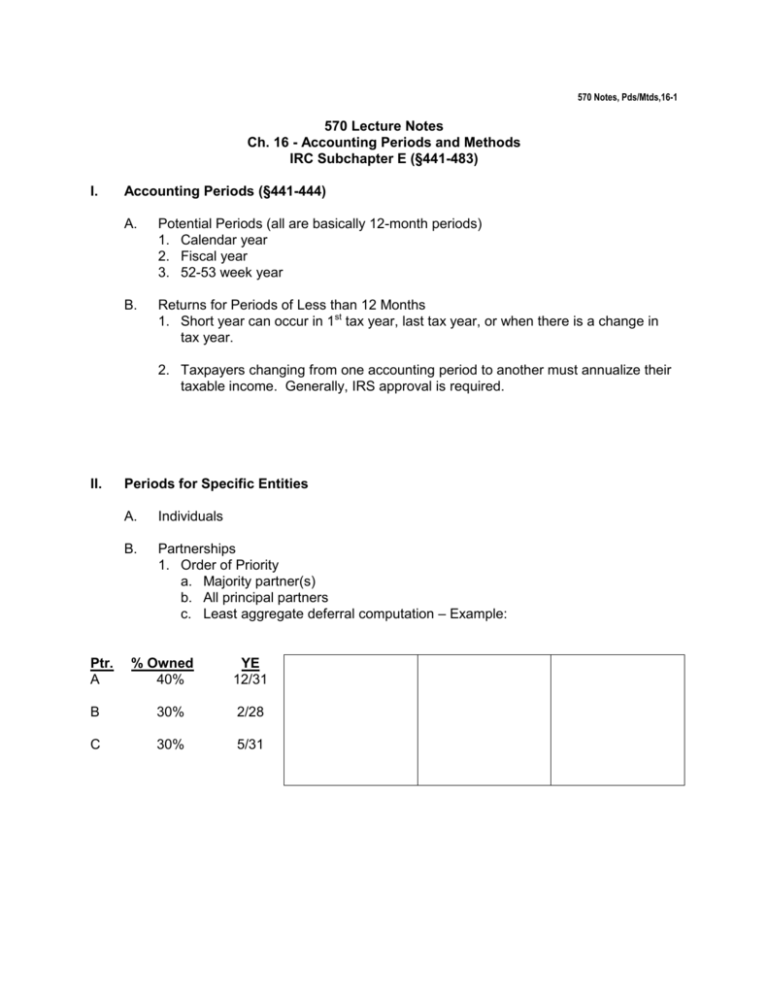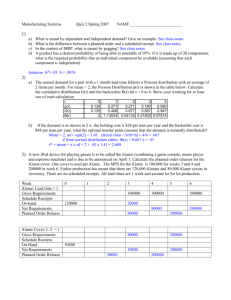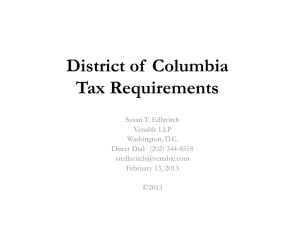475 Lecture Notes
advertisement

570 Notes, Pds/Mtds,16-1
570 Lecture Notes
Ch. 16 - Accounting Periods and Methods
IRC Subchapter E (§441-483)
I.
Accounting Periods (§441-444)
A.
Potential Periods (all are basically 12-month periods)
1. Calendar year
2. Fiscal year
3. 52-53 week year
B.
Returns for Periods of Less than 12 Months
1. Short year can occur in 1st tax year, last tax year, or when there is a change in
tax year.
2. Taxpayers changing from one accounting period to another must annualize their
taxable income. Generally, IRS approval is required.
II.
Ptr.
A
Periods for Specific Entities
A.
Individuals
B.
Partnerships
1. Order of Priority
a. Majority partner(s)
b. All principal partners
c. Least aggregate deferral computation – Example:
% Owned
40%
YE
12/31
B
30%
2/28
C
30%
5/31
570 Notes, Pds/Mtds,16-2
2.
Exceptions
a. Business Purpose (Natural business year)
Defn: A 2-month period in which > 25% of annual gross receipts received for
at least 3 consecutive years.
(Note: if more than one such 2-month period exists, the natural business
year is the period with the largest average.)
b. §444 election
1. Limit
2.
C.
Required deposit
partnership (not owners) deposits tax
does not earn interest
deposit = [Partnership Taxable Income x 36% x n/12], where n is # months
deferred
required only if deposit amount> $500
S Corporations
1. Calendar Year or 52/53 Week
2. Exceptions
business purpose (natural business year)
§444 election with required deposit
D.
C Corporations
E.
Personal Service Corporations
Defn: PSC is a corporation whose shareholder-employees provide personal
services (e.g., medical, legal, accounting, consulting, etc)
1. Calendar Year
2. Exceptions
business purpose (natural business year)
§444 election, but ONLY IF:
o the corporations pays the shareholder-employee’s salary during
the deferral period AND
o the salary for that period is at least proportionate to the salary
paid for the fiscal year.
Example: PSC has 10/31 year-end (a 2-month deferral). Its shareholderemployee was paid $60,000 in salary for the 11/1-10/31 fiscal year. PSC
must pay the shareholder-employee a salary of at least $10,000 ($60,000 x
2/12) in November and December.
570 Notes, Pds/Mtds,16-3
II.
Overall Accounting Methods (§446)
General rules:
taxable income must be determined under the method taxpayer regularly uses
for computing income in maintaining its books, provided it clearly reflects
income and is used consistently.
Same method used in determining revenues must be used for expenses.
A.
Cash Receipts and Disbursements Method
1. Income recognized for the tax year in which cash or property is actually or
constructively received.
a. Exceptions for U.S. savings bonds (optional for discounts, required for
premiums) and OID bonds (required)
2. Expenses are generally deducted in the year paid. Prepaid expenses which
have a life > 1 year beyond the end of the year must be capitalized.
3. Restrictions on the use of cash method
a. Cash method cannot be used by businesses in which inventory is an "income
producing factor."
1. Exceptions:
- “qualifying taxpayers” (avg. gross receipts<$1m in last 3 years);
- “qualified small businesses” (avg. gross receipts < $10m in last 3 yrs &
either certain industry code or principal business is services or custom
work).
2. Hybrid method possible.
b. Cash method cannot be used by (exceptions for farmers):
1. C corporations with avg. gross receipts in last 3 years > $5million;
2. partnerships with C Corp partners & avg. gross receipts in last 3 years >
$5million;
3. tax shelters.
B.
Accrual Method
1. Income and expenses are both subject to:
a. all-events test
Defn: all events have occurred to establish the existence of the income or
expense and the amount can be determined with reasonable accuracy.
b. economic performance test (for deductions)
Defn: In general, services must have been performed to be deductible.
2. Exception for income received in advance.
a. General: Taxpayer must recognize income when cash is received.
b. Exceptions (deferral possible):
- Sales of inventory not shipped & gift certificates (maximum deferral is 2
yrs). Note – requires GAAP conformity.
- Service contracts (maximum deferral is 1 yr)
570 Notes, Pds/Mtds,16-4
C.
Change of Method (§481)
1. Must obtain IRS permission to change method.
2. Involves an adjustment to “catch-up”
Example: Change from the Cash to the Accrual Basis
A journal entry approach is helpful for illustrating the tax consequences of a change in methods.
To illustrate this approach, assume a C corporation’s average annual gross receipts for 2007
through 2009 exceeded $5,000,000. Therefore, effective January 1, 2010 the company was
required to change to the accrual method of accounting. On January 1, 2010 the company’s
cash basis and accrual basis accounts were as follows:
Cash Basis
Accrual Basis
Assets
Cash
$ 75,000
$ 75,000
Accounts receivable
0
125,000
Supplies
0
80,000
Equipment (net of depreciation)
400,000
400,000
Total
$475,000
$680,000
$
0
$ 31,000
Note payable
100,000
100,000
Stockholder’s equity
375,000
549,000
$475,000
$680,000
Liabilities and Stockholder’s Equity
Accrued expenses
Total
Journal Entry
Debit
Accounts receivable
$125,000
Supplies
$ 80,000
Credit
Accrued expenses
$ 31,000
§481Adjustment to income
$174,000
Note that the § 481 adjustment to income is the amount required to make the journal entry
balance after all of the asset and liability accounts have been adjusted.
Note also that as a voluntary change by the taxpayer the adjustment, generally, can be spread
over four years (i.e., $43,500 added to 2010 income and an equal amount added to 2011,
2012, and 2013 income).
570 Notes, Pds/Mtds,16-5
III.
Inventories (§471–475)
A.
Determination of Inventory Cost
1. Retailers use normal accounting procedures
2. Manufacturers must use full absorption costing (the uniform capitalization
rules apply to manufacturers with > $10million in gross receipts). Includes:
(a) Direct labor and materials
(b) Manufacturing overhead including factory repairs and maintenance, utilities,
rent, insurance, small tools, tax depreciation, factory administration and
officers' salaries related to production, taxes (other than income), quality
control and inspection, rework, scrap, spoilage, current and past service
costs of pension and profit-sharing plans, and service support.
IV.
B.
Cost flow assumptions
1. Normal rules used in accounting (LIFO, FIFO, average)
2. Retail method
3. Dollar-value LIFO
4. Restrictions on LIFO
C.
Cost departures (LCM)
1. Lower of cost or market (replacement cost) must be applied item-by-item.
2. Not available for LIFO.
Special Accounting Methods
A.
Installment Sales Method (§453)
1. Description: When any disposition of property for a gain occurs where at least
one payment is received after the taxable year of disposition, the installment sale
rules apply (i.e., the method is automatic, unless taxpayer elects out by reporting
entire gain in the year of sale). The income is reported proportionately over the
period payments are received.
Easy Example to remind you that you already know this: Asset with a basis of
$50,000 is sold for $90,000. Collection is $30,000/year for 3 years, with a
reasonable interest paid.
570 Notes, Pds/Mtds,16-6
2. Restrictions on installment method.
a. Not available for inventory, publicly-traded stock & securities, depreciation
recapture, & sales of depreciable property between related parties.
3. General computations Required:
a. Contract Price = Selling Price - debt transferred to buyer
b. Gross profit percentage = Gross Profit/Contract Price
c. Annual income recognition = GP% times the collections of principal
Example: Suppose from the easy example that the $90,000 sales price is
$80,000 3-yr. note ($26,667/yr) & assumption of a $10,000 mortgage.
GP% = Gain / Cont. Pr. =
Yr
1
2
3
$ collected
GP %
GP Recog.
4. Special computations
a. Debt assumed by buyer exceeds seller's basis (plus selling expenses):
(1) excess added to contract price
(2) excess treated as cash received in year of sale
(3) net effect is a GP% of 100%
Example: Suppose from the easy example that the $90,000 sales price is
$30,000 3-yr note ($10k/yr) & assumption of a $60,000 mortgage.
Gain / Cont. Pr. =
40,000
= 100%
90,000 – 60,000 + 10,000
Yr
1
2
3
$ collected
10,000
10,000
10,000
Excess
10,000
GP %
100%
100%
100%
GP Recog.
20,000
10,000
10,000
b. All depreciation recapture must be recognized in year of disposition. GP%
must be adjusted to reflect recognition.
Example: Suppose from the easy example that the $40,000 gain consists of
$10,000 depreciation recapture under §1245.
GP% = Gain / Cont. Pr. =
Yr
1
2
3
$ collected
GP %
GP Recog.
c. Interest on the note must be reasonable (based on AFR), or we impute one.
Effect is simply reclassification of character of income to be recognized.
570 Notes, Pds/Mtds,16-7
B.
Long-Term Contracts (§460)
Defn: Contract that is not completed within the same taxable year in which it began.
1. Potential methods
a. Percentage of completion
b. Completed contract
2. Restrictions on completed contract. Available only for (i.e., default requires
percentage of completion):
a. Certain home construction contracts:
At least 80% of estimated costs are for dwelling units in buildings with no
more than 4 units.
b. 2-year construction projects by "small" contractors
(average gross receipts < $10M)
3. Special Provisions
a. Percentage of Completion - can ignore income recognition if <10% complete
at year-end.
b. Percentage of Completion Look-Back Rule
1. Potential interest payment/receipt applies to construction projects that
exceed 2 years and are > $1M.
2. In the year of completion, we must recalculate the profit and related
taxes to actual.
570 Notes, Pds/Mtds,16-8
Example: Percentage of Completion Method
Contract started in 2008 and was completed in 2010
Contract price
Estimated total cost at beginning
Estimated costs changed in 2009 to
Actual cost incurred:
2008 =
$ 250,000
2009 =
$1,000,000
2010 =
$ 250,000
$1,600,000
$1,000,000
$1,500,000
Percentage of Completion Profit
Formula:
Revenue this year – Costs this year = Profit this year,
where Revenue = [(Total Contract x % complete to date) – Prior Years’ Revenue]
2008
2009
2010
=
=
[$1,600,000 X $250,000/$1,000,000] - $250,000
$400,000 - $250,000 =
(You may have learned to recognize profits, which are computed as:
[$600,000 est. profit X $250,000/$1,000,000])
=
=
{[$1,600,000 X $1,250,000/$1,500,000] - $400,000} - $1,000,000
$1,333,333 - $400,000 - $1,000,000 =
(Continuing with profit method:
{[$100,000 est. profit x $1,250,000/$1,500,000] - $150,000})
=
=
{($1,600,000 X $1,500,000/$1,500,000) - $1,333,333} - $250,000
$266,667 - $250,000 =
Total profit = $150,000 - $66,667 + $16,667 =
$150,000
(66,667)
16,667
$100,000
Look-back Profits for Each Year
2008 $1,600,000 X ($250,000/$1,500,000) - $250,000 =
2009 $1,600,000 X ($1,000,000/$1,500,000) - $1,000,000 =
2010 $1,600,000 X ($250,000/$1,500,000) - $250,000 =
$16,667
$66,667
$16,667
Thus, the taxpayer will receive interest on the difference in tax on $150,000 reported in 2008
and the tax on the corrected income, $16,667. The interest will be calculated as though the
company loaned the government the tax when it filed its 2008 return and the government repaid
the loan when the 2010 return was filed. For 2009, the taxpayer is deemed to have borrowed
the tax on $133,334 ($66,667 + $66,667) for one year, assuming the $66,667 loss reported in
2009 was offset against other income. No interest is due or receivable with respect to 2010
taxes because the difference between the actual and estimated profit is adjusted in that year.






